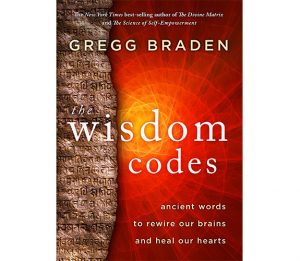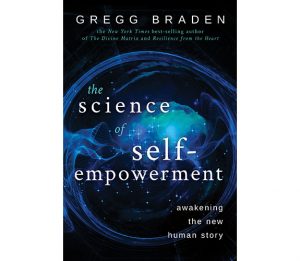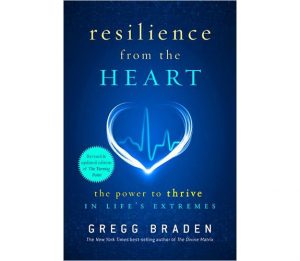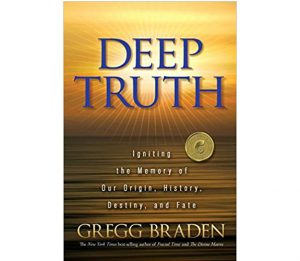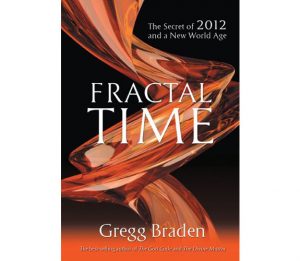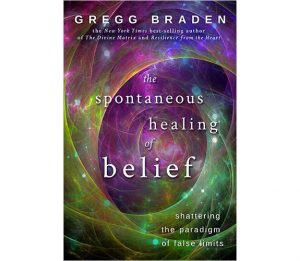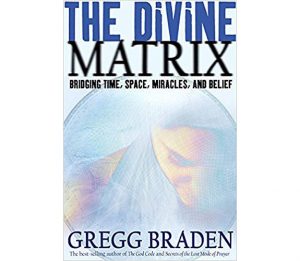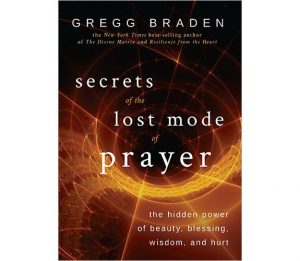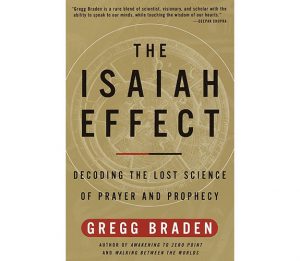Please select one of Gregg Braden’s books below to view its citations and reference section.
The Wisdom Codes: Resources
The Wisdom Codes – 1st Edition, May 2020
Epigraph, “A single word has the power to influence the expression of genes . . .” Andrew Newberg, M.D., and Mark Robert Waldman, Words Can Change Your Brain: 12 Conversation Strategies to Build Trust, Resolve Conflicts, and Increase Intimacy (New York: Hudson Street Press, 2012), 3.
1. “I know nothing in the world that has as much power as a word.” Emily Dickinson, Letters.
 Introduction
Introduction
1. Benjamin Lee Whorf, “Science and Linguistics,” first published in MIT Technology Review 42, no. 6 (April 1940): 229–31; reprinted in Language, Thought, and Reality: Selected Writings of Benjamin Lee Whorf, ed. John B. Carroll (Cambridge, MA: The MIT Press, Massachusetts Institute of Technology, 1956), 212–214. Benjamin Lee Whorf died from cancer in 1941 before he had the opportunity to publish a complete version of his theories. Although he successfully published a series of papers before his death, including the aforementioned article, the definitive representations of his work were published posthumously by colleagues such as G. L. Trager, who published the definitive paper “The Systematization of the Whorf Hypothesis.” This is among the papers that are typically used to reference Whorf’s ideas today.
2. Roberto Cazzolla Gatti, “A Conceptual Model of New Hypothesis on the Evolution of Biodiversity,” Biologia 71, no. 3 (March 2016): 343, https://doi.org/10.1515/ biolog-2016-0032. The best science of the 21st century has overturned 150 years of thinking based upon Charles Darwin’s model for the fundamental principle of natural systems. In fact, nature is based upon cooperation, not competition.
3. “A single word has the power to influence the expression of genes . . .” Andrew Newberg, M.D., and Mark Robert Waldman. Words Can Change Your Brain: 12 Conversation Strategies to Build Trust, Resolve Conflicts, and Increase Intimacy (New York: Hudson Street Press, 2012), 3. This landmark book supports the ideas that Benjamin Lee Whorf proposed earlier in the 20th century and takes the word-human relationship from the level of neurons deeper to the level of gene expression.
4. “Over time the structure of your thalamus will also change . . .” Andrew Newberg, M.D., and Mark Robert Waldman, in “Words Can Change Your Brain,” Therese J. Borchard, PsychCentral.com, May 27, 2019, https://psychcentral.com/blog/words-can- change-your-brain-2.
How to Use the Wisdom Codes
1. The Quick Coherence Technique was developed by the HeartMath Institute, founded in 1991. It is based on three decades of important groundbreaking research in neurobiology that has led to new discoveries about the presence of neurons in the heart, heart/brain coherence, and the relationship between the human heart and the magnetic fields of the Earth.
2. For scientific details of heart/brain coherence, read the first two chapters in my book Resilience from the Heart: The Power to Thrive in Life’s Extremes (Carlsbad, CA: Hay House, 2015). This book was originally released under the title The Turning Point: Creating Resilience in a Time of Extremes (2014). It was retitled to emphasize the techniques and applications of heart focus and heart-based coherence for personal resilience.
The Words Are the Codes
1. “Words can light fires in the minds of men . . .” Patrick Rothfuss, The Name of the Wind (New York: DAW Books, 2007).
2. “Whatsoever ye shall ask the Father in my name . . .” John 16:23 (King James Version). In 1604, King James I of England commissioned a new translation of the Bible. Since its publication in 1611, this version has been the standard for many groups of English-speaking Protestants.
3. “Ask without hidden motive and be surrounded by your answer . . .” Neil Douglas-Klotz, translator, Prayers of the Cosmos: Meditations on the Aramaic Words of Jesus (San Francisco, CA: Harper San Francisco, 1994), 86–87.
4. “Mountain, move away . . .” “The Gospel of Thomas (II, 2),” Helmut Koester and Thomas O. Lambdin, in The Nag Hammadi Library, ed. James M. Robinson (New York: HarperCollins, 1990), 137. The scrolls known collectively as the Nag Hammadi Library—the oldest and most complete records known to exist of the New Testament texts—were discovered in 1945 in Egypt, only a year before the Dead Sea Scrolls were discovered in the caves of Qumran. The discovery was especially significant, as well as controversial, because the find revealed that many texts had been removed from the biblical canon used by the Catholic Church in the 4th century, including this gospel.
 Part One: PROTECTION
Part One: PROTECTION
Epigraph. “Craig D. Lounsbrough Quotes,” Goodreads.com, accessed August 12, 2019.
Wisdom Code 1: Psalm 91
1. Of the various translations of Psalm 91, I chose the English translation that is most widely accepted and accessible for the nonacademic readers, the King James Version.
2. “Blessed be Abram by God Most High . . .” Holy Bible: From the Ancient Eastern Text, George M. Lamsa’s Translation from the Aramaic of the Peshitta, trans. George M. Lamsa (Philadelphia: A. J. Holman Company, 1933). The word peshitta means “common” in the Syriac language, and is the name given to a translation of the Christian Bible from around the 3rd century.
Wisdom Code 2: Buddhist Prayer of Refuge
1. Lobsang Wangdu, “How to Say the Refuge Prayer in Tibetan,” YoWangdu.com, accessed August 19, 2019, https://www.yowangdu.com/tibetan-buddhism/refuge-prayer.html. The Tibetan Prayer of Refuge (kyamdro) is a traditional Buddhist prayer. While the theme of every translation I have read appears the same, nuances of interpretations are reflected in the various translations. For reasons of clarity and accuracy, for Wisdom Code 2 I’ve chosen a translation by Lobsang Wangdu. A Tibetan living in the United States, he was formerly a Buddhist monk and holds a master’s degree in Madyamika from the Institute of Buddhist Dialectics in Dharamsala, India. Wangdu’s blog post on kyamdro includes a video of him pronouncing the Prayer of Refuge in the Tibetan language.
Wisdom Code 3: The Lord’s Prayer
1. “Our Father in heaven, hallowed be thy name. . .” Holy Bible: From the Ancient Eastern Text, George M. Lamsa’s Translation from the Aramaic of the Peshitta, trans. George M. Lamsa (Philadelphia: A. J. Holman Company, 1933). As is the case with so many of the wisdom codes, the words of the Lord’s Prayer exist today in numerous translations that reflect people’s various interpretations of this text. The Peshitta version of the Bible is the name given to a translation of the Christian Bible from the original Syriac dialect of Aramaic used around the 3rd century. I’ve chosen George M. Lamsa’s translation of the Peshitta version of the Lord’s Prayer because he was a native Aramaic speaker. This translation appears to be closer to the original language that Jesus would have used to reveal the prayer in his day.
2. Burton L. Mack, The Lost Gospel: The Book of Q and Christian Origins (San Francisco: Harper One, 2013).
3. “This form of Aramaic is very similar to, . . .” Stephen Andrew Missick, “The Lord’s Prayer in the Original Aramaic,” Aramaic Herald, March 18, 2011, http://aramaicherald.blogspot.com/2011/03/lords-prayer-in-original-aramaic-by.html.
4.. This quote is from a portion of his blog that summarizes his views and research contained in his book The Language of Jesus: Introducing Aramaic (Amazon Digital Services, LLC, 2010).
5. The Revised Standard Version (RSV) of the Bible was released in 1952 and does not include the Byzantine doxology, for the reasons described in Wisdom Code 3. The RSV uses both the King James Version and American Standard Version as its primary source texts. The purpose of the RSV was to make the Bible more readable for contemporary people by removing words that are no longer commonly used, such as thou, thee, and speaketh, while honoring the original intent and theme of the text.
6. “The doxology . . . appears later for the first time in the Didache . . .” The doxology is absent in the book of Luke, and in the Revised Standard Version of the Lord’s Prayer, Matthew 6:9–13. It first appears in the Didache text (circa 1 c.e.), as part of what are considered to be the second-generation Christian writings.
7. “Abwoon d’bwashmaya . . .” Neil Douglas-Klotz, translator, Prayers of the Cosmos: Meditations on the Aramaic Words of Jesus (San Francisco: Harper San Francisco, 1994). While there are many possible translations and layers of meaning associated with the Aramaic language, I’ve favored and often relied upon this particular translation since it was first released in 1990. I’m including it here as a reference for the Lord’s Prayer, as well as other significant works such as the Aramaic translation of the Beatitudes.
Wisdom Code 4: Gayatri Mantra
1. “Brahma, the manifestation of spiritual energy . . .” Swami Vivekananda, The Complete Works of the Swami Vivekananda, Volume One (Advaita Ashram, 2016). This first volume in a nine-volume set celebrates the 150th anniversary of Swami Vivekananda’s birth in 1863 and offers a deeper exploration of the traditional Hindu mantras, including the Gayatri.
2. “O thou existence Absolute, Creator of the three dimensions. . .” Shri Gyan Rajhans. “The Gayatri Mantra.” Learn Religions, June 12, 2019, https://www.learnreligions.com/the-gayatri-mantra-1770541. The age of the Vedas is uncertain. Scholars commonly attribute the origin of the Rig Veda, the oldest of the Vedas, to a date of approximately 1100–1700 b.c.e. Some scholars, however, suggest that the texts may have originated as long as 7,000 years ago. As with many texts of such antiquity, there are many translations, based upon many interpretations of the original text. While I have chosen the beautiful and precise translation of Kumud Ajmani, Ph.D., for Wisdom Code 4, other translations are available and may vary in their specifics.
3. “Aum Bhur Bhuvah Swah . . .” Kumud Ajmani, “Gayatri Mantra Word by Word Meaning,” Glimpses of Divinity: The EagleSpace Blog, January 25, 2018, https://blog.eaglespace.com/gayatri-mantra-words. This discussion of the Gayatri Mantra is one of the best, most concise, and accurate that I’ve come across in my research.
 Part Two: FEAR
Part Two: FEAR
Epigraph. Pema Chödrön, When Things Fall Apart: Heart Advice for Difficult Times (Boston: Shambhala Publications, 1997), 22.
1. Candace Pert, Molecules of Emotion: The Science Behind Mind-Body Medicine (New York: Simon and Schuster, 1999). I had the privilege of meeting and getting to know Pert before she died in 2013. We were both publishing and distributing our books through Hay House, and the I Can Do It! conferences of the time were tremendous opportunities for speakers to meet and support one another’s work. I have tremendous respect for her paradigm-altering work documenting the body’s production of chemicals (neuropeptides) from emotional experiences and the role of unresolved emotion and trauma in hindering the body’s ability to metabolize these chemicals.
2. Karl Albrecht, “The (Only) 5 Fears We All Share,” Psychology Today blog, March 22, 2012. The fear of annihilation is first on the list of the five fears that we share universally as humans. A psychologist, Albrecht concisely identifies and describes these fears and the role they play in our lives.
3. The law of conservation of energy is a fundamental principle of thermodynamics. Rather than being a discovery that occurred in a moment in time, recognition of this physical law evolved gradually over centuries, with roots in the observations of astronomer and physicist Galileo in the 1600s. In 1842, Julius Robert von Mayer formalized the principle in the expression that “energy can be neither created, nor destroyed.” This is a key concept when it comes to the consideration of human immortality and the ultimate fate of the energy of the soul.
Wisdom Code 5: Katha Upanishad
1. “The soul is not born, nor does it die . . .” Swami Mukundananda, “Bhagavad Gita: Chapter 2, Verse 20,” Bhagavad Gita: The Song of God, accessed August 9, 2019, https://www.holy-bhagavad-gita.org/chapter/2/verse/20. While the words of Wisdom Code 5 are found in the Upanishad as described in the text, a nearly identical version is also found in the Bhagavad Gita, chapter 2, verse 20: “The soul is neither born, nor does it ever die; nor having once existed, does it ever cease to be. The soul is without birth, eternal, immortal, and ageless. It is not destroyed when the body is destroyed.”
Wisdom Code 6: Pyramid Texts
1. R. O. Faulkner, The Ancient Egyptian Pyramid Texts (Stilwell, KS.: Digireads.com, 2007), 42. This 1969 translation is my primary source for this chapter. Of the many and varied translations that are now available for the Pyramid Texts, I’ve found British Egyptologist Faulkner’s to be the most accurate, concise, and consistent with the translations that I received from the Egyptian guides who first led me into the chambers below the Unas Pyramid in 1986. Faulkner contributed to the translation of the Pyramid Texts that is available as an accompaniment to images of the hieroglyphics, chamber by chamber, online at https://www.pyramidtextsonline.com/translation.html.
Wisdom Code 7: Bhagavad Gita
1. Swami Mukundananda, trans. and commentary, Bhagavad Gita: The Song of God (Dallas: Jagadguru Kripaluji Yog, 2017). This is my primary source for this chapter.
2. “The soul is never created, nor does it ever die . . .” Mukundananda, “Bhagavad Gita: Chapter 2, Verse 20,” accessed August 9, 2019, https://www.holy-bhagavad-gita.org/chapter/2/verse/20.
3. “That which pervades the entire body . . .” Mukundananda, “Bhagavad Gita: Chapter 2, Verse 17,” accessed August 9, 2019, https://www.holy-bhagavad-gita.org/chapter/2/verse/17.
4. “Weapons cannot shred the soul . . .” Mukundananda, “Bhagavad Gita: Chapter 2, Verse 23,” https://www.holy-bhagavad-gita.org/chapter/2/verse/23.
5. “The soul is unbreakable and incombustible. . .” Mukundananda, “Bhagavad Gita: Chapter 2, Verse 24,” https://www.holy-bhagavad-gita.org/chapter/2/verse/24.
Wisdom Code 8: The Gospel of Peace
1. “One day your body will return to the Earthly Mother . . .” Edmond Bordeaux Szekely, The Essene Gospel of Peace: Book One (Baja California: International Biogenic Society, 1981). As a young man, Szekely was sent to study at the Vatican in Rome. Around 1923 he was given access to the private Vatican Library, where he discovered the Aramaic gospel of Jesus’s teachings. While he was not allowed to remove the documents from the library, he was allowed to transcribe them. Book One is the first of the four books that resulted from Bordeaux’s translations.
2. “Our ‘Mother Earth’ and our ‘Father in Heaven’ . . .” Szekely, 56–7.
3. “And you shall be one with the Holy Stream of Light . . .” Szekely, 58.
 Part Three: LOSS
Part Three: LOSS
Epigraph. “Norman Cousins Quotes,” BrainyQuote.com, BrainyMedia Inc., accessed August 12, 2019, https://www.brainyquote.com/quotes/norman_cousins_121747.
1. “Nature abhors a vacuum.” Aristotle, Physics, Book IV, chapters 6–9 (circa 350 b.c.e.).
2. Gregg Braden, Secrets of the Lost Mode of Prayer: The Hidden Power of Beauty, Blessing, Wisdom and Hurt (Carlsbad, CA: Hay House, 2006), 173–7.
Wisdom Code 9: Otagaki Rengetsu
1. Otagaki Rengetsu, trans. John Stevens, Rengetsu: Life and Poetry of Lotus Moon (Brattleboro, VT: Echo Point Books and Media, 2014), 32. The Buddhist principle of impermanence that is the foundation of Wisdom Code 9 is described poetically in the work of the 19th-century Buddhist nun Otagaki Rengetsu. This book is my source for her work.
2. For a detailed discussion of the three marks of existence, I recommend the work of Vietnamese Buddhist monk Thich Nhat Hahn, especially his book The Heart of the Buddha’s Teaching: Transforming Suffering into Peace, Joy, and Liberation (New York: Harmony, 1999), 141. The Buddhist teachings exist as layers of increasingly deep and subtler meaning.
Wisdom Code 10: Buddha
1. As I did in Wisdom Code 9, I refer you to the work of Vietnamese Buddhist monk Thich Nhat Hahn. The Heart of the Buddha’s Teaching: Transforming Suffering into Peace, Joy, and Liberation (New York: Harmony Books, 1999).
“What we experience as ‘balance’ is actually a temporary state of harmony . . .” Gregg Braden, The Divine Matrix: Bridging Time, Space, Miracles, and Belief (Carlsbad CA.: Hay House, 2007), 187–9. For a discussion of how this principle often plays out in our lives, please see Part III.
Wisdom Code 11: Pavamana Mantra
1. Swami Prabhavananda and Fredrick Manchester, The Upanishads: Breath of the Eternal, 2nd ed. (Hollywood, CA: Vedanta Press, 1975), 80. The Pavamana Mantra was written approximately 2,700 years ago as part of the Brihadaranyaka Upanishad. As one of the primary Upanishads of Hinduism, the Brihadaranyaka is specifically dedicated to the exploration and metaphysics of the human soul (atman). While the Sanskrit text has remained as a stable text, there are many and varied English translations available. For the purposes of this book, I’ve chosen this translation of the Pavamana Mantra.
2. For additional commentary on word meanings, refer to Om Asato Maa Sad-Gamaya; look at https://en.wikipedia.org/wiki/Pavamana_Mantra.
3. “Transformation of the individual and their environment . . .” John Campbell, as cited in Shira Atkins, “A Beginner’s Guide to Essential Sanskrit Mantras,” Sonima, August 21, 2015, https://www.sonima.com/yoga/sanskrit-mantras.
 Part Four: STRENGTH
Part Four: STRENGTH
Epigraph. “Katherine Dunham Quotes,” Goodreads.com, accessed August 11, 2019, https://www.goodreads.com/quotes/592751-go-within-every-day-and-find-the-inner-strength-so.
1. George Gurdjieff wrote a series of books chronicling his mysterious journey to find the hidden teachings that became the central focus of his life. He published the French edition of his book Meetings with Remarkable Men: All and Everything in 1960. It was translated into English in 1963 and released as the film Meetings with Remarkable Men, written and directed by Peter Brook, in 1979. Gurdjieff called this book the first in his “second series” of writings.
2. Alfredo Metere, “Does Free Will Exist in the Universe? (That Would Be a No.)” Cosmos, July 18, 2018, https://cosmosmagazine.com/physics/does-free-will-exist-in-the-universe-that-would-be-a-no. While the conversation regarding choice and free will is often relegated to philosophical texts, it also goes directly to the essence of why Part Four is so powerful. This beautifully and responsibly written exploration of this powerful concept in an easy-to-read format was penned by a senior research scientist at the International Computer Science Institute.
Wisdom Code 12: Beauty Prayer
1. Shonto Begay, “Shonto Begay,” Indian Artist 3, no. 1 (winter 1997), 52. The informal version of the Beauty Prayer that I chose to begin the chapter is one I saw expressed by native artist Shonto Begay in a New Mexico–based art magazine, Indian Artist. While the magazine appears to no longer be active, I’m including the reference here for clarity.
2. “This powerful code forms the closing prayer of the Blessing Way Ceremony . . .” For a detailed discussion of how the Navajo ceremonies are performed, please see the Navajo Song Ceremonial Complex: https://en.wikipedia.org/wiki/Navajo_song_ceremonial_complex.
3. “The beauty that you live with . . .” Mark Sublette, “Shonto Begay, Native American Painter,” Canyon Road Arts: The Complete Visitors Guide to Arts, Dining and the Santa Fe Lifestyle, March 10, 2013.
The full-length English translation of the Beauty Prayer was produced by Robert S. Drake for Tom Holm, Ph.D., University of Arizona American Indian Graduate Studies Program, Native American Religions and Spirituality. Read online and listen to a recording of Wayne Wilson reading the prayer in the original Navajo tongue: “Walk in Beauty: Prayer from the Navajo People,” Talking Feather: Lesson Plans about Native American Indians, accessed August 19, 2019, https://talking-feather.com/home/walk-in-beauty-prayer-from-navajo-blessing.
Wisdom Code 13: Vedic Mantra
In writing this chapter, I relied primarily upon three articles.
1. Michael Ireland, “Meditation and Psychological Health and Functioning: A Descriptive and Critical Review,” Scientific Review of Mental Health Practice 9, no. 1 (May 2012), 4–19. This paper describes a scientific evaluation and benefits of various meditation practices.
2. Jai Paul Dudeja, “Scientific Analysis of Mantra-Based Meditation and Its Beneficial Effects: An Overview,” International Journal of Advanced Scientific Technologies in Engineering and Management Sciences 3, no. 6 ( June 2017), 21–6. Modern science is taking the ancient science of mantras seriously as the physical, as well as physiological are now well-documented. This journal reference describes one of these studies.
3. Ramesh, “Om Namah Shivaya–Meaning and Its Significance,” Vedicfeed, June 24, 2018, https://vedicfeed.com/om-namah-shivaya-meaning. The Vedic mantra Om Namah Shivaya is an ancient mantra and traditional chant. The author breaks down the syllables of the mantra and shows how they pair to the elements of nature and the seven chakras.
4. “Mantras have a very specific effect on our mental, emotional, physical and spiritual states.” Martin Schmidt In Asia, “Enchanted Chanting: Experiencing Peace and Purity in the High School Classroom,” Social Conscience and Inner Awakening blog, September 12, 2018, https://martinschmidtinasia.wordpress.com/2018/09/12/enchanted-chanting-experiencing-peace-and-purity-in-the-high-school-classroom/.
5. “Now I am become death, the destroyer of worlds . . .” Swami Mukundananda, Bhagavad Gita: The Song of God, chapter 11, verses 31–33, https://www.holy-bhagavad-gita.org/chapter/11/verse/32.
Wisdom Code 14: Psalm 23
“The Lord is my shepherd . . .” For my biblical reference of the 23rd Psalm, in this chapter I have chosen the New International Version (NIV) for the reasons described in the text. For a comparison of the NIV version of Psalm 23 to the English Standard Version (ESV), I recommend https://www.biblegateway.com/passage/?search=Psalm+23&version=ESV;Niv.
“I am the shepherd of the people who causes the truth to appear . . .” Stan Rummel, “The Hammurabi Stele: Partially Retold in English,” K. C. Hanson’s Home Page, accessed August 27, 2019, http://www.kchanson.com/ANCDOCS/meso/hammurabi.html. This English translation a very readable version of the text from the ancient Hammurabi stele, a stone monument with a record of 282 laws imposed by the king of Babylon in 1754 b.c.e.
 Part Five: LOVE
Part Five: LOVE
Epigraph. Kate McGahan, Only Gone from Your Sight: Jack McAfghan’s Little Guide to Pet Loss and Grief (Kate McGahan: 2018).
1. “Your task is not to seek for love . . .” Goodreads.com, accessed August 13, 2019, https://www.goodreads.com/quotes/1268078-your-task-is-not-to-seek-for-love-but-merely.
2. “Forgiveness doesn’t excuse what another person has done . . .” Andrea Brandt, Ph.D., M.F.T., “How Do You Forgive Even When It Feels Impossible? (Part 1),” Psychology Today, September 2, 2014.
3. “Blessed is the man who has suffered, and found life . . .” Helmut Koester and Thomas O. Lambdin, “The Gospel of Thomas (II, 2),” in The Nag Hammadi Library, rev. ed., James M. Robinson, ed. (New York: HarperCollins, 1990), 132.
4. “That which you have will save you if you bring it forth from yourselves . . .” Koester and Lambdin, “The Gospel of Thomas (II, 2),” 134.
5. “Through the power of love, we can let go of past history . . .” Ernest Holmes Quotes, AZ Quotes (accessed August 13, 2019), https://www.azquotes.com/author/6840-Ernest_Holmes.
6. “By forgiving, you are accepting the reality of what happened . . .” Brandt, “How Do You Forgive Even When It Feels Impossible? (Part 1).”
Wisdom Code 15: Gospel of Thomas
1. “I forgive them for killing my parents . . .” Ofer Aderet. “Holocaust Survivor Known for Forgiving Nazis Dies at 85 on Trip to Auschwitz,” Haaretz, July 4, 2019.
2. “If you bring forth what is within you, what you bring forth will save you . . .” Koester and Lambdin, “The Gospel of Thomas (II, 2),” 134.
 Part Six: THE POWER CODES
Part Six: THE POWER CODES
Epigraph. Yehuda Berg. “The Power of Words,” HuffPost, November 27, 2011, https://www.huffpost.com/entry/the-power-of-words_b_716183.
Power Code 1: I Will
1. “What happens on earth is but a pale reflection . . .” Michael Wise; Martin Abegg, Jr.; and Edward Cook, trans. and commentary, “The Songs of the Sabbath Sacrifice,” in The Dead Sea Scrolls: A New Translation (New York: Harper San Francisco, 1996), 365.
2. “We live in a world . . . which exists independently of us human beings . . .” Alice Calaprice, ed. The Expanded Quotable Einstein (Princeton, N.J.: Princeton University Press, 2000), 220.
3. “We had this old idea, that there is a universe out there . . .” F. David Peat, Synchronicity: The Bridge Between Matter and Mind (New York: Bantam Books, 1987), 4.
4. “Like vast space where nothing is lacking and nothing is in excess . . .” Richard B. Clarke. Hsin-Hsin Ming: Seng-ts’an, Third Zen Patriarch (Buffalo, NY: White Pine Press, 2011), 11. The Hsin-Hsin Ming is attributed to Chien Chih Seng-ts’an, third Zen patriarch, in the 6th century.
5. “Lord, if thou wilt, thou canst make me clean.” King James Version, Matthew 8:2–3.
Power Code 2: I Am
1. “I Am that I Am.” King James Version, Exodus 3:14. The words that God spoke to Moses in response to the question of his identity.
2. “Thus shalt thou say unto the children of Israel . . .” Exodus 3:15.
3. “The Universal Field does not judge the appropriateness of what we give it to reflect . . .” Braden, The Divine Matrix, 161–4. For an expanded discussion of our relationship to the scientifically acknowledged field of energy that connects all things, I refer you to my earlier work.
4. “‘Mountain, move away’ it will move away . . .” Koester and Lambdin, “The Gospel of Thomas (II, 2),” 137.
 Part Seven: THE PARABLES
Part Seven: THE PARABLES
Epigraph. Roger C. Schank. Tell Me a Story: Narrative and Intelligence (Evanston, IL: Northwestern University Press, 1995).
1. “Additional examples of rock paintings discovered to have survived in caverns in Southern France . . .” In 1994 explorers discovered a previously sealed cave in southern France, with 425 images on the cave walls depicting 14 different species of animals. Carbon dating suggests the images are at least 32,000 years old, making them the oldest documented cave images to date. Director Werner Herzog explored the Chauvet cave in his documentary film Cave of Forgotten Dreams.
Parable 1: The Woman and the Jar
1. “Who are we . . . but the stories we tell about ourselves . . .” Scott Turow, Ordinary Heroes (New York: Grand Central Publishing, 2011), 6.
Filmmaker Werner Herzog captured images of the world’s oldest known cave paintings in his outstanding 2010 documentary Cave of Forgotten Dreams, https://en.wikipedia.org/wiki/Cave_of_Forgotten_Dreams.
2. “Humans are not ideally set up to understand logic . . .” Schank, Tell Me a Story.
3. “Refines the neural pathways that lead to skillful navigation of life’s problems . . .” Jonathan Gottschall, The Storytelling Animal: How Stories Make Us Human (New York: Mariner Books, 2012), 67.
4. “These are the hidden words that the living Jesus spoke . . .” Koester and Lambdin, “The Gospel of Thomas (II, 2),” 126.
5 “The kingdom of the father is like a certain woman who was carrying a jar full of meal . . .” Koester and Lambdin, “The Gospel of Thomas (II, 2),” 126.
6. “And when you say, ‘Mountain, move away,’ it will move away . . .” Koester and Lambdin, “The Gospel of Thomas (II, 2),” 137.
Parable 2: The Poison Arrow
1. “Suppose a man is struck by a poisoned arrow . . .” Thich Nhat Hanh, Zen Keys: A Guide to Zen Practice (New York: Harmony, 1994), 42.

